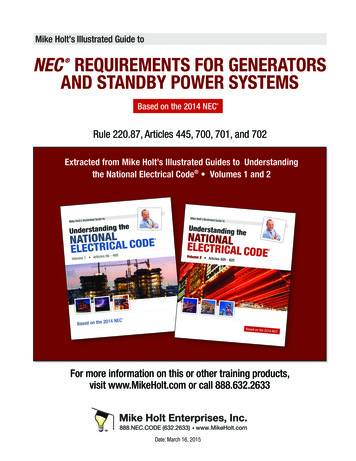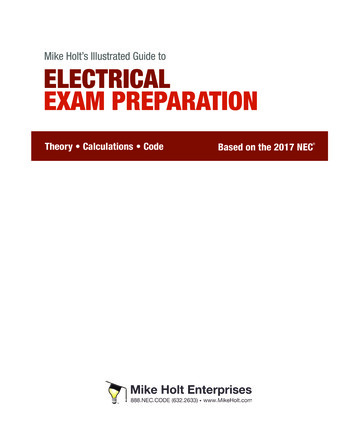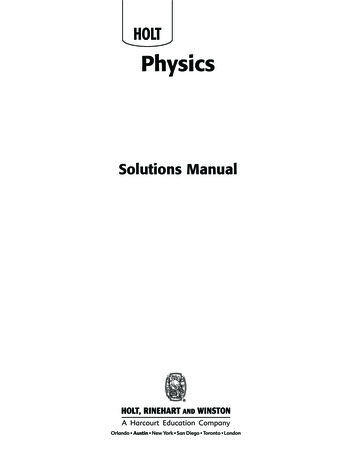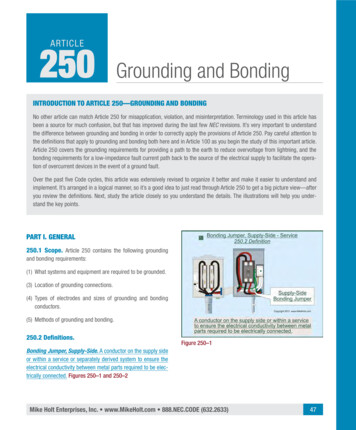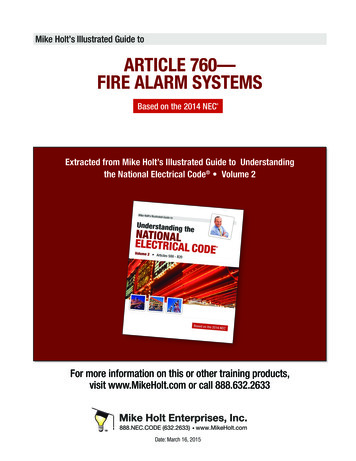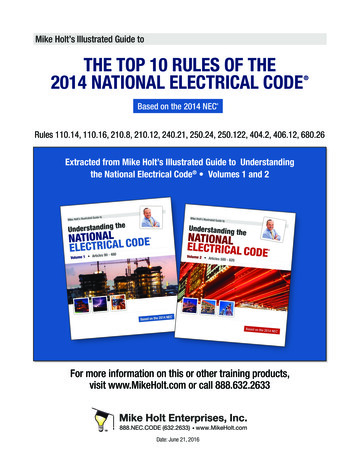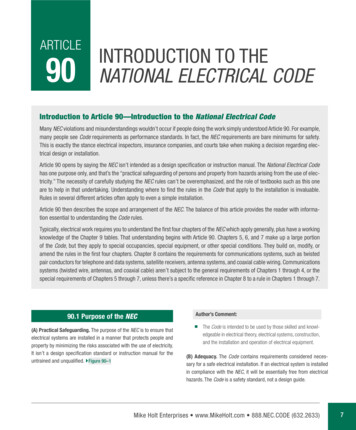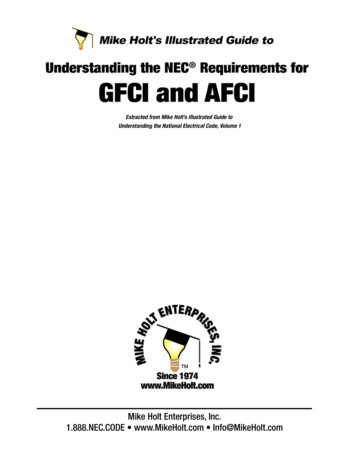
Transcription
Extracted from Mike Holt’s Illustrated Guide toUnderstanding the National Electrical Code, Volume 1Mike Holt Enterprises, Inc.1.888.NEC.CODE www.MikeHolt.com Info@MikeHolt.com
GFCI Protection(A) Dwelling Units. GFCI protection is required for all 15Aand 20A, 125V receptacles located in the following locationsof a dwelling unit:Author’s Comment: See the definitions of GFCI and DwellingUnit in Article 100.(1) Bathroom Area. GFCI protection is required for all 15Aand 20A, 125V receptacles in the bathroom area of a dwelling unit. Figure 210–11Figure 210–12Author’s Comments: See the definition of “Garage” in Article 100. A receptacle outlet is required in a dwelling unit attachedgarage [210.52(G)], but a receptacle outlet isn’t required inan accessory building or a detached garage without power.If a 15A or 20A, 125V receptacle is installed in an accessorybuilding, it must be GFCI protected. Figure 210–13Figure 210–11Author’s Comments: See the definition of “Bathroom” in Article 100. In the continued interests of safety, proposals to allow receptacles for dedicated equipment in the bathroom area to beexempted from the GFCI protection requirements have beenrejected.(2) Garages and Accessory Buildings. GFCI protection isrequired for all 15A and 20A, 125V receptacles in garages,and in grade-level portions of accessory buildings used forstorage or work areas of a dwelling unit. Figure 210–122Figure 210–13Mike Holt’s Illustrated Guide to Understanding the NEC Requirements for GFCI and AFCI Protection
(3) Outdoors. All 15A and 20A, 125V receptacles located outdoors of dwelling units, including receptacles installed underthe eaves of roofs, must be GFCI protected. Figure 210–14Figure 210–15Figure 210–14Author’s Comments: Each dwelling unit of a multifamily dwelling that has anindividual entrance at grade level must have at least oneGFCI-protected receptacle outlet accessible from grade levellocated not more than 6½ ft above grade [210.52(E)(2)]. Balconies, decks, and porches over 20 sq ft that are attachedto the dwelling unit and are ac cessible from inside the dwelling must have at least one GFCI-protected receptacle outletaccessible from the balcony, deck, or porch [210.52(E)(3)].Exception: GFCI protection isn’t required for a fixed electricsnow-melting or deicing equipment receptacle supplied by adedicated branch circuit, if the receptacle isn’t readily accessible and the equipment or receptacle has ground-fault protection of equipment (GFPE) [426.28]. Figure 210–15Figure 210–16(4) Crawl Spaces. All 15A and 20A, 125V receptacles installedin crawl spaces at or below grade of a dwelling unit must beGFCI protected.Exception: A receptacle supplying only a permanently installedfire alarm or burglar alarm system is not required to be GFCIprotected [760.41(B) and 760.121(B)].Author’s Comment: The Code doesn’t require a receptacle tobe installed in a crawl space, except when heating, air-conditioning, and refrigeration equipment is installed there [210.63].Author’s Comment: A receptacle outlet is required in eachunfinished portion of a dwelling unit basement [210.52(G)].(5) Unfinished Basements. GFCI protection is required forall 15A and 20A, 125V receptacles located in the unfinishedportion of a basement not intended as a habitable room andlimited to storage and work areas. Figure 210–16(6) Kitchen Countertop Surfaces. GFCI protection is requiredfor all 15A and 20A, 125V receptacles that serve countertopsurfaces in a dwelling unit. Figure 210–17Author’s Comments: GFCI protection is required for all receptacles that servecountertop surfaces. But GFCI protection isn’t required for3Mike Holt’s Illustrated Guide to Understanding the NEC Requirements for GFCI and AFCI Protection
Figure 210–17receptacles that serve built-in appliances, such as dishwashers or kitchen waste disposals. See 210.52(C) for the location requirements of countertopreceptacles.Figure 210–19(8) Boathouses. GFCI protection is required for all 15A and20A, 125V receptacles located in a dwelling unit boathouse.Figure 210–20(7) Laundry, Utility, and Wet Bar Sinks. GFCI protection isrequired for all 15A and 20A, 125V receptacles located withinan arc measurement of 6 ft from the sink. Figures 210–18 and210–19Figure 210–20Author’s Comment: The Code doesn’t require a 15A or 20A,125V receptacle to be installed in a boathouse, but if one isinstalled, it must be GFCI protected.(B) Other than Dwelling Units. GFCI protection is requiredfor all 15A and 20A, 125V receptacles installed in the following commercial/industrial locations:Figure 210–184(1) Bathrooms. All 15A and 20A, 125V receptacles installedin commercial or industrial bathrooms must be GFCI protected. Figure 210–21Mike Holt’s Illustrated Guide to Understanding the NEC Requirements for GFCI and AFCI Protection
Author’s Comments: GFCI protection is not required for receptacles rated otherthan 15A and 20A, 125V in these locations. GFCI protection is not required for hard-wired equipment inthese locations.(3) Rooftops. All 15A and 20A, 125V receptacles installed onrooftops must be GFCI protected. Figure 210–23Figure 210–21Author’s Comments: See the definition of a “Bathroom” in Article 100. A 15A or 20A, 125V receptacle isn’t required in a commercialor industrial bathroom, but if one is installed, it must be GFCIprotected.(2) Kitchens. All 15A and 20A, 125V receptacles installed in anarea with a sink and permanent facilities for food preparationand cooking [Article 100], even those that don’t supply thecountertop surface, must be GFCI protected. Figure 210–22Figure 210–23Author’s Comment: A 15A or 20A, 125V receptacle outlet mustbe installed within 25 ft of heating, air-conditioning, and refrigeration equipment [210.63].Exception: GFCI protection isn’t required for a fixed electricsnow-melting or deicing equipment receptacle that isn’t readilyaccessible [426.28].(4) Outdoors. All 15A and 20A, 125V receptacles installedoutdoors must be GFCI protected. Figure 210–24Exception No. 1 to (3) and (4): GFCI protection isn’t requiredfor a fixed electric snow-melting or deicing equipment receptacle supplied by a dedicated branch circuit, if the receptacle isn’treadily accessible and the equipment or receptacle has groundfault protection of equipment (GFPE) [426.28].Figure 210–22(5) Sinks. All 15A and 20A, 125V receptacles installed within6 ft of the outside edge of a sink must be GFCI protected.Figure 210–25(C) Boat Hoists. GFCI protection is required for outlets notexceeding 240 volts that supply boat hoists in dwellingunit locations. Figure 210–265Mike Holt’s Illustrated Guide to Understanding the NEC Requirements for GFCI and AFCI Protection
Figure 210–24Figure 210–26Author’s Comments: See the definition of “Outlet” in Article 100. This ensures GFCI protection regardless of whether the boathoist is cord-and-plug-connected or hard-wired.Figure 210–256Mike Holt’s Illustrated Guide to Understanding the NEC Requirements for GFCI and AFCI Protection
AFCI Protection(A) AFCI Definition. An arc-fault circuit interrupter is adevice intended to de-energize the circuit when it detects thecurrent waveform characteristics unique to an arcing fault.Figures 210–34 and 210–35(B) Dwelling Unit Circuits. All 15A or 20A, 120V branchcircuits in dwelling units supplying outlets in family rooms,dining rooms, living rooms, parlors, libraries, dens, bedrooms, sunrooms, recreation rooms, closets, hallways, orsimilar rooms or areas must be protected by a listed AFCIdevice of the combination type. Figure 210–36Figure 210–34Figure 210–36Author’s Comment: The 120V circuit limitation means AFCIprotection isn’t required for equipment rated 230V, such as abaseboard heater or room air conditioner. For more information,visit www.MikeHolt.com, click on the “Search” link, and searchfor “AFCI.”FPN No. 3: See 760.41(B) and 760.121(B) for power-supplyrequirements for fire alarm systems.Figure 210–357Author’s Comment: Smoke alarms connected to a 15A or 20Acircuit of a dwelling unit must be AFCI protected if the smokealarm is located in one of the areas specified In 210.12(B).The exemption from AFCI protection for the “fire alarm circuit”contained in 760.41(B) and 760.121(B) doesn’t apply to the single-or multiple-station smoke alarm circuit typically installed inMike Holt’s Illustrated Guide to Understanding the NEC Requirements for GFCI and AFCI Protection
dwelling unit bedroom areas. This is because a smoke alarmcircuit isn’t a fire alarm circuit as defined in NFPA 72, NationalFire Alarm Code. Unlike single-or multiple-station smoke alarms,fire alarm systems are managed by a fire alarm control panel.Figure 210–37Exception No. 1: The AFCI protection can be located at thefirst outlet if the circuit conductors are installed in RMC, IMC,EMT or steel armored Type AC cable, and the AFCI device iscontained in a metal outlet or junction box.Exception No. 2: AFCI protection can be omitted for branchcircuit wiring to a fire alarm system in accordance with760.41(B) and 760.121(B), if the circuit conductors areinstalled in RMC, IMC, EMT, or steel armored Type ACcable.Figure 210–378Mike Holt’s Illustrated Guide to Understanding the NEC Requirements for GFCI and AFCI Protection
7 Mike Holt’s Illustrated Guide to Understanding the NEC Requirements for GFCI and AFCI Protection (A) AFCI Definition. An arc-fault circuit interrupter is a device intended to de-energize the circuit when it detects the cu

